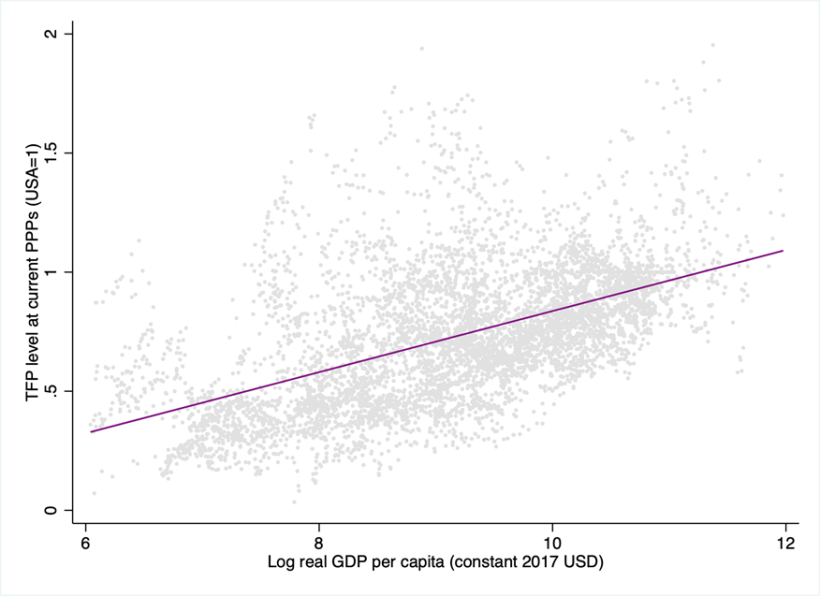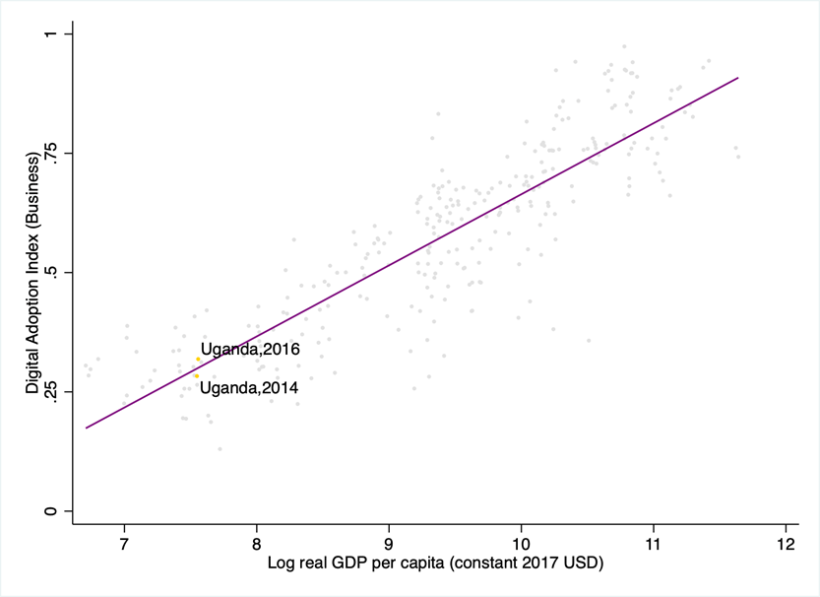
Leveraging technology and investment to achieve sustainable growth in Uganda
Uganda needs to navigate a journey towards digital transformation to achieve sustainable economic growth and to attract foreign investment.
The rapid development of digital infrastructure and applications alongside cheaper devices have made digital technology the prime driver of technological advances across the globe. Digital trade has the potential to open new markets for developing countries and overcome economic constraints such as market distance. However, barriers to more widespread use persist. Overcoming these barriers and identifying drivers of technology adoption are key for designing policies aimed at fostering productivity growth to spur economic development.
A foundational tenet of economics is the role of productivity in shaping differences in development. This is illustrate in Figure 1 which shows how vast disparities in total factor productivity (TFP) levels across countries significantly contribute to variations in their GDP per capita. Alongside the efficient use of production factors across firms and geography, technology adoption is key to understanding differences in productivity. Often used as a catch-all term, technology refers to everything that allows for the production and distribution of goods and services in a faster, cheaper, and better way.
IGC Uganda co-hosted the 7th Economic Growth Forum in Kampala with the Ministry of Finance, Planning, and Economic Development to discuss Uganda’s productivity agenda, the importance of technology, and the critical role of economic policy to make use of modern technology with Marius Oboje, Martina Ferracane, Aminah Zawedde , and Martin Muhasi.
Figure 1: The relationship between capital and economic output

Notes: This figure illustrates the relationship between the log real GDP per capita and the level of capital content. It shows a positive correlation between the log real GDP per capita and the level of capital content. This means that countries with higher levels of capital content tend to have higher levels of economic development. Source: Penn World Tables.
The vital Role of productivity drivers
Marius Oboje embarked on this discussion by "removing the veil" around the concept of productivity. Echoing Paul Krugman, he noted that in the long-run productivity is almost everything, serving as the linchpin for economic growth. Understanding the nuances of technology adoption and advancement is crucial to decipher productivity trends. From human capital development to firm-level considerations such as innovation and R&D, the drivers of productivity growth are manifold. While agriculture has observed significant output growth globally (primarily through TFP), Africa and Uganda in particular still lag behind. For Uganda to bridge this gap, strategies ranging from public investments spurring private ventures to more optimal resource allocation, and improved macroeconomic conditions, are imperative.
Understanding the and navigating the digital future
Aminah Zawedde, the permanent Secretary (PS) of the Ministry of ICT opened the session by discussing the critical role of digital transformation in Uganda’s productivity and economic growth. Figure 2 shows that like TFP, digital adoption by businesses as a measure of digitalisation is strongly correlated with the level of economic development. Uganda’s digital adoption levels are in line with its income level, but fostering digital transformation could unlock a wide range of untapped potential for growth. For low-income countries digitalisation has a vast potential to catch up to the productivity frontier as it lowers communication costs, and enhances access to information and services. In particular, it promotes entrepreneurship by opening new ways to engage in digital trade. Beyond mere online purchases, digital trade encompasses four pillars: trade in digital and ICT goods, value-adding online services, investments in pivotal sectors like cloud computing, and data movement and utilisation. Overcoming physical barriers, this offers a wide range of new market opportunities such as digital trade of educational and health services.
Figure 2: The relationship between GDP and digital adoption

Notes: The Digital Adoption Index is the simple average of four normalised indicators. The percentage of businesses with a website, the number of secure servers, the speed of download and the coverage of 3g in the country. The data covers a wide range of countries across income levels and geography and includes the years 2014 and 2016. In Uganda, digital adoption has grown with the GDP. Source: Penn World Tables and World Bank.
Widespread adoption of digital technology requires an efficient and effective regulatory environment and key public sector investments. The PS outlined a forward-looking five-year roadmap. This plan underscores the need for bolstered connectivity, laying the infrastructure groundwork for widespread internet access, and ensuring people have ready access to devices. Digital services, in this roadmap, aren't merely an afterthought—they're critical for improving efficiency and transparency in governmental operations. Cybersecurity and data protection are highlighted as pivotal for fostering a trustworthy digital environment. Skilling is deemed indispensable for Uganda's digital transformation, from the grassroots-level where farmers should be adept at utilising informational apps, right up to equipping higher-level professionals like data analysts with the tools to make informed decisions. Encouraging innovation and entrepreneurship emerged as the final pillar of this plan.
Digital trade as an engine for growth
Martina Ferracane discussed the potential of digital trade as a catalyst for economic growth, highlighting its integral role in technological and digital transformation. For Uganda, embracing digital trade can lead to benefits like reduced communication costs, better access to information and services, and job creation through startups. Innovations like Mobile Money (MoMo) exemplify the potential to bypass traditional inefficiencies, providing more streamlined access to essential financial services.
However, challenges persist. Martina Ferracane's data analysis indicates that Uganda’s ICT exports stand at only 0.15%, lagging behind regional counterparts with digital services witnessing intermittent growth. Despite adopting some progressive policies, Uganda has untapped avenues for digital transformation such as liberalising digital trade through commitments in the AfCFTA and open data transfer commitments. Martina Ferracane advocates for a strategic regulatory approach, emphasising clear objectives, efficiency, adherence to international standards, and fostering regional and international collaborations, notably through mechanisms like the AfCFTA.
Boosting productivity with Foreign Direct Investment
As the director of the Uganda Investment Authority (UIA), Martin Muhasi discussed the potential of Foreign Direct Investment (FDI) to boost productivity, specifically in the agricultural sector. FDI brings a multitude of benefits, including access to advanced technology, managerial expertise, and broader market reach. Uganda, recognising this potential, has implemented policies to attract FDI, such as tax incentives for industrial park investments, and aligned this with its national development plan which targets specific sectors such as agroprocessing, tourism, and ICT. A notable strategy is their plan to bridge the gap between graduates and FDI firms, ensuring a skilled workforce for these enterprises.
A country’s investment landscape is also shaped by factors like ease of doing business, political stability, human resources, and tailored investment incentives. Martin Muhasi outlined how Uganda and the UIA have been proactive in this domain, having launched the National SME portal. This portal aims to foster connections by offering technological support, skill development, and financial resources to local businesses. It serves as a hub for data aggregation, promoting visibility for local firms, and facilitating matchmaking between potential investors and local enterprises through an investor monitoring tool.
The role of technology and investments in economic growth
The strategic embrace of technology and investments is indispensable for sustainable economic growth. However, challenges persist as Uganda faces barriers such as suboptimal digital adoption, lagging ICT exports, and an untapped potential in digital trade.
The insights shared at the 7th Economic Growth Forum provide a roadmap to navigate these challenges. Aminah Zawedde underscored the role of efficient regulatory environments and public sector investments in fostering digital transformation. Martina Ferracane highlighted the opportunities within digital trade, emphasising its potential to bypass traditional market barriers. While Marius Oboje stressed the importance of understanding technology nuances to improve productivity.
Lastly, Martin Muhasi highlighted the transformative power of FDI, suggesting policies to attract such investments. To conclude, while Uganda faces challenges in its digital transformation journey, it also has actionable strategies to overcome them. Uganda can foster digital transformation, that increases productivity growth and ensures its transition to a modern, high-income economy.

